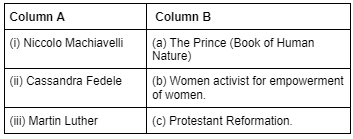All Exams >
UPSC >
Famous Books for UPSC Exam (Summary & Tests) >
All Questions
All questions of Changing Cultural Traditions for UPSC CSE Exam
The painting 'Mona Lisa' was made by- a)Leonardo da Vinci.
- b)Michelangelo.
- c)Raphael.
- d)Donatello.
Correct answer is option 'A'. Can you explain this answer?
The painting 'Mona Lisa' was made by
a)
Leonardo da Vinci.
b)
Michelangelo.
c)
Raphael.
d)
Donatello.
|
|
Neerajmaddheshiya answered |
Leonardo da Vinci! frm 1503 to 1517
Renaissance is best known for its- a)cultural developments.
- b)social develoments.
- c)political developments.
- d)economic developments.
Correct answer is option 'A'. Can you explain this answer?
Renaissance is best known for its
a)
cultural developments.
b)
social develoments.
c)
political developments.
d)
economic developments.
|
|
Anjali Khanna answered |
Renaissance is a cultural movement that spanned roughly the 14th century to the 17th century. This movement began in Florence in the Late Middle Ages and later spread to the rest of the Europe. Although the Renaissance saw revolutions in many intellectual pursuits, as well as social and political upheavals, it is best known for its artistic developments.
Petrarch was given the title of ‘Poet Laureate’ in Rome in- a)1341.
- b)1342.
- c)1343.
- d)1344.
Correct answer is option 'A'. Can you explain this answer?
Petrarch was given the title of ‘Poet Laureate’ in Rome in
a)
1341.
b)
1342.
c)
1343.
d)
1344.
|
|
Pooja Choudhury answered |
Petrarch was an Italian scholar, poet and humanist. A major force in the development of the Renaissance, he was famous for his poems addressed to Laura. He was crowned as a poet laureate in Rome.
Anatomy, geometry, physics, as well as a strong sense of what was beautiful, gave a new quality to Italian art, which was to be called- a)aesthetic realism
- b)epistemological realism
- c)philosophical realism
- d)realism
Correct answer is option 'D'. Can you explain this answer?
Anatomy, geometry, physics, as well as a strong sense of what was beautiful, gave a new quality to Italian art, which was to be called
a)
aesthetic realism
b)
epistemological realism
c)
philosophical realism
d)
realism
|
|
Manpreet Kalra answered |
Realism
Direction: For each part choose from the following:Assertion (A): Humanists thought that they were restoring ‘true civilization’ after centuries of darkness.Reason (R): They believed that a ‘dark age’ had set in after the collapse of the Roman Empire.- a)Both A and R are true and R is the correct explanation of A.
- b)Both A and R are true but R is not the correct explanation of A.
- c)A is true but R is false.
- d)A is false but R is true.
Correct answer is option 'A'. Can you explain this answer?
Direction: For each part choose from the following:
Assertion (A): Humanists thought that they were restoring ‘true civilization’ after centuries of darkness.
Reason (R): They believed that a ‘dark age’ had set in after the collapse of the Roman Empire.
a)
Both A and R are true and R is the correct explanation of A.
b)
Both A and R are true but R is not the correct explanation of A.
c)
A is true but R is false.
d)
A is false but R is true.
|
|
Sarthak Banerjee answered |
Assertion (A): Humanists thought that they were restoring ‘true civilization’ after centuries of darkness.
Reason (R): They believed that a ‘dark age’ had set in after the collapse of the Roman Empire.
The correct answer is option 'A', which means that both the assertion and the reason are true, and the reason is the correct explanation of the assertion.
Explanation:
Humanists, also known as Renaissance humanists, were scholars, writers, and intellectuals during the Renaissance period (14th to 17th century) in Europe. They sought to revive and emulate the intellectual and cultural achievements of classical antiquity, particularly that of ancient Greece and Rome. The assertion states that humanists thought they were restoring 'true civilization' after centuries of darkness, which implies that they believed they were bringing back the glory and intellectual pursuits of the past.
The reason provided is that humanists believed a 'dark age' had set in after the collapse of the Roman Empire. This refers to the period known as the Middle Ages or Medieval period, which followed the fall of the Western Roman Empire in the 5th century. During this time, Europe experienced political instability, economic decline, and a lack of intellectual and cultural progress compared to the classical civilizations of Greece and Rome. The reason suggests that humanists believed they were emerging from this dark age and working towards a restoration of civilization.
Supporting Evidence:
1. Humanists focused on the study of classical texts, such as those of Plato, Aristotle, and Cicero, which they considered to be the epitome of knowledge and wisdom. They believed that by studying and emulating these works, they could revive the intellectual achievements of the past and create a more enlightened society.
2. Humanists placed a strong emphasis on education and the liberal arts, including subjects like literature, history, philosophy, and rhetoric. They believed that a well-rounded education in these subjects would lead to the development of virtuous and knowledgeable individuals who could contribute to the betterment of society.
3. Humanists also advocated for the use of vernacular languages, such as Italian or English, in addition to Latin. This was a departure from the practice of using Latin as the exclusive language of the educated elite. By promoting the use of vernacular languages, humanists aimed to make knowledge and literature more accessible to a wider audience, thus spreading the benefits of civilization to a larger population.
Conclusion:
In conclusion, the assertion that humanists believed they were restoring 'true civilization' after centuries of darkness is supported by the reason that they believed a 'dark age' had set in after the collapse of the Roman Empire. The humanists' focus on the revival of classical knowledge, emphasis on education, and promotion of vernacular languages all point to their belief in the restoration of a more enlightened and civilized society.
Reason (R): They believed that a ‘dark age’ had set in after the collapse of the Roman Empire.
The correct answer is option 'A', which means that both the assertion and the reason are true, and the reason is the correct explanation of the assertion.
Explanation:
Humanists, also known as Renaissance humanists, were scholars, writers, and intellectuals during the Renaissance period (14th to 17th century) in Europe. They sought to revive and emulate the intellectual and cultural achievements of classical antiquity, particularly that of ancient Greece and Rome. The assertion states that humanists thought they were restoring 'true civilization' after centuries of darkness, which implies that they believed they were bringing back the glory and intellectual pursuits of the past.
The reason provided is that humanists believed a 'dark age' had set in after the collapse of the Roman Empire. This refers to the period known as the Middle Ages or Medieval period, which followed the fall of the Western Roman Empire in the 5th century. During this time, Europe experienced political instability, economic decline, and a lack of intellectual and cultural progress compared to the classical civilizations of Greece and Rome. The reason suggests that humanists believed they were emerging from this dark age and working towards a restoration of civilization.
Supporting Evidence:
1. Humanists focused on the study of classical texts, such as those of Plato, Aristotle, and Cicero, which they considered to be the epitome of knowledge and wisdom. They believed that by studying and emulating these works, they could revive the intellectual achievements of the past and create a more enlightened society.
2. Humanists placed a strong emphasis on education and the liberal arts, including subjects like literature, history, philosophy, and rhetoric. They believed that a well-rounded education in these subjects would lead to the development of virtuous and knowledgeable individuals who could contribute to the betterment of society.
3. Humanists also advocated for the use of vernacular languages, such as Italian or English, in addition to Latin. This was a departure from the practice of using Latin as the exclusive language of the educated elite. By promoting the use of vernacular languages, humanists aimed to make knowledge and literature more accessible to a wider audience, thus spreading the benefits of civilization to a larger population.
Conclusion:
In conclusion, the assertion that humanists believed they were restoring 'true civilization' after centuries of darkness is supported by the reason that they believed a 'dark age' had set in after the collapse of the Roman Empire. The humanists' focus on the revival of classical knowledge, emphasis on education, and promotion of vernacular languages all point to their belief in the restoration of a more enlightened and civilized society.
Direction: Read the following extract carefully and answer ANY THREE of the following questions by choosing the correct option:Formal education was not the only way through which humanist shaped the mind of their age. Art, architecture and books were wonderfully effective in transmitting humanist ideas.Artists were inspired by studying works of the past. The material remains of Roman culture were sought with as much excitement as ancient text: a thousand years after the fall of Rome, fragments of art were discovered in the ruins of ancient Rome and other deserted cities. Their admiration for the figures of perfectly proportioned men and women sculpted so many centuries ago, made Italian sculptors want to continue that tradition. In 1416, Donatello (1386-1456) broke new ground with his life-like statues.Q. Which of the following was perfectly related to the thoughts of Humanism?- a)Free thinking
- b)Reasoning
- c)Selfishness
- d)Both (a) and (b)
Correct answer is option 'D'. Can you explain this answer?
Direction: Read the following extract carefully and answer ANY THREE of the following questions by choosing the correct option:
Formal education was not the only way through which humanist shaped the mind of their age. Art, architecture and books were wonderfully effective in transmitting humanist ideas.
Artists were inspired by studying works of the past. The material remains of Roman culture were sought with as much excitement as ancient text: a thousand years after the fall of Rome, fragments of art were discovered in the ruins of ancient Rome and other deserted cities. Their admiration for the figures of perfectly proportioned men and women sculpted so many centuries ago, made Italian sculptors want to continue that tradition. In 1416, Donatello (1386-1456) broke new ground with his life-like statues.
Q. Which of the following was perfectly related to the thoughts of Humanism?
a)
Free thinking
b)
Reasoning
c)
Selfishness
d)
Both (a) and (b)
|
|
Arun Yadav answered |
Humanism is a philosophical stance that emphasizes the individual and social potential and agency of human beings. It considers human beings as the starting point for serious moral and philosophical inquiry.
The families that gave more importance to women during the 15th century were those of- a)aristocrats.
- b)artists.
- c)merchants.
- d)scholars.
Correct answer is option 'C'. Can you explain this answer?
The families that gave more importance to women during the 15th century were those of
a)
aristocrats.
b)
artists.
c)
merchants.
d)
scholars.
|
|
Krish Chaudhary answered |
The position of women in the families of merchants was somewhat different from that of aristocratic families. Shopkeepers were very often assisted by their wives in running their shops. In families of merchants and bankers, wives looked after the businesses when the male members were away on work.
Write true or false against the following statements:Andreas Vesalius wrote his-On Anatomy in 1575.- a)True
- b)False
Correct answer is option 'B'. Can you explain this answer?
Write true or false against the following statements:
Andreas Vesalius wrote his-On Anatomy in 1575.
a)
True
b)
False
|
|
Rajesh Gupta answered |
In 1543, at the young age of 29, Vesalius published his most important work, De Humani Corporis Fabrica Libri Septem (Seven Books on the Fabric of the Human Body), generally known as the Fabrica. The Fabrica is the most famous anatomy book ever written and also the first book on human anatomy to be reasonably accurate.
Direction: Read the following extract carefully and answer ANY THREE of the following questions by choosing the correct option:Formal education was not the only way through which humanist shaped the mind of their age. Art, architecture and books were wonderfully effective in transmitting humanist ideas.Artists were inspired by studying works of the past. The material remains of Roman culture were sought with as much excitement as ancient text: a thousand years after the fall of Rome, fragments of art were discovered in the ruins of ancient Rome and other deserted cities. Their admiration for the figures of perfectly proportioned men and women sculpted so many centuries ago, made Italian sculptors want to continue that tradition. In 1416, Donatello (1386-1456) broke new ground with his life-like statues.Q. After studying the extract, what do you think what are the main factors which effectively transmit humanist ideas?- a)Art
- b)Architecture
- c)Books
- d)All of these
Correct answer is option 'D'. Can you explain this answer?
Direction: Read the following extract carefully and answer ANY THREE of the following questions by choosing the correct option:
Formal education was not the only way through which humanist shaped the mind of their age. Art, architecture and books were wonderfully effective in transmitting humanist ideas.
Artists were inspired by studying works of the past. The material remains of Roman culture were sought with as much excitement as ancient text: a thousand years after the fall of Rome, fragments of art were discovered in the ruins of ancient Rome and other deserted cities. Their admiration for the figures of perfectly proportioned men and women sculpted so many centuries ago, made Italian sculptors want to continue that tradition. In 1416, Donatello (1386-1456) broke new ground with his life-like statues.
Q. After studying the extract, what do you think what are the main factors which effectively transmit humanist ideas?
a)
Art
b)
Architecture
c)
Books
d)
All of these
|
|
Kiran Mehta answered |
Formal education was not the only way through which humanists shaped the minds of their age. Art, architecture and books were wonderfully effective in transmitting humanist ideas.
Direction: For each part choose from the following:Assertion (A): From 1417, the popes became politically stronger.Reason (R): They actively encouraged the study of Rome’s history.- a)Both A and R are true and R is the correct explanation of A.
- b)Both A and R are true but R is not the correct explanation of A.
- c)A is true but R is false.
- d)A is false but R is true.
Correct answer is option 'B'. Can you explain this answer?
Direction: For each part choose from the following:
Assertion (A): From 1417, the popes became politically stronger.
Reason (R): They actively encouraged the study of Rome’s history.
a)
Both A and R are true and R is the correct explanation of A.
b)
Both A and R are true but R is not the correct explanation of A.
c)
A is true but R is false.
d)
A is false but R is true.
|
|
Anuj Patel answered |
Assertion (A): From 1417, the popes became politically stronger.
Reason (R): They actively encouraged the study of Rome’s history.
The correct answer is option B, which states that both Assertion (A) and Reason (R) are true, but R is not the correct explanation of A. Let's discuss each statement in detail to understand the reasoning behind this answer.
Explanation:
From 1417, the popes did indeed become politically stronger. This can be attributed to the Council of Constance, which was held from 1414 to 1418. The council aimed to resolve the Western Schism, a period of time when there were rival popes and a division within the Catholic Church. The council successfully elected Pope Martin V as the sole legitimate pope, thus ending the schism. With the resolution of this conflict, the papacy regained its authority and political power.
Reasoning behind Assertion (A):
The political strengthening of the popes after 1417 was primarily a result of the Council of Constance. The council's decision to elect a single pope helped to restore unity within the Catholic Church and consolidate papal power. The popes were able to assert their authority more effectively and exert political influence both within and outside the church.
Reasoning behind Reason (R):
The reason given, that the popes actively encouraged the study of Rome's history, is not a direct cause of their political strengthening. While it is true that the popes did support the study of Rome's history during this period, this alone does not explain their political strength. The study of Rome's history was part of a broader intellectual and cultural movement known as the Renaissance, which had an impact on various aspects of society, including the papacy. However, it was the resolution of the Western Schism and the subsequent unity of the Catholic Church that played a more significant role in the popes' political strengthening.
Conclusion:
In conclusion, Assertion (A) is true as the popes did become politically stronger from 1417. However, Reason (R) is not the correct explanation of this assertion. While the popes did encourage the study of Rome's history, it was the resolution of the Western Schism through the Council of Constance that primarily contributed to their political strengthening.
Reason (R): They actively encouraged the study of Rome’s history.
The correct answer is option B, which states that both Assertion (A) and Reason (R) are true, but R is not the correct explanation of A. Let's discuss each statement in detail to understand the reasoning behind this answer.
Explanation:
From 1417, the popes did indeed become politically stronger. This can be attributed to the Council of Constance, which was held from 1414 to 1418. The council aimed to resolve the Western Schism, a period of time when there were rival popes and a division within the Catholic Church. The council successfully elected Pope Martin V as the sole legitimate pope, thus ending the schism. With the resolution of this conflict, the papacy regained its authority and political power.
Reasoning behind Assertion (A):
The political strengthening of the popes after 1417 was primarily a result of the Council of Constance. The council's decision to elect a single pope helped to restore unity within the Catholic Church and consolidate papal power. The popes were able to assert their authority more effectively and exert political influence both within and outside the church.
Reasoning behind Reason (R):
The reason given, that the popes actively encouraged the study of Rome's history, is not a direct cause of their political strengthening. While it is true that the popes did support the study of Rome's history during this period, this alone does not explain their political strength. The study of Rome's history was part of a broader intellectual and cultural movement known as the Renaissance, which had an impact on various aspects of society, including the papacy. However, it was the resolution of the Western Schism and the subsequent unity of the Catholic Church that played a more significant role in the popes' political strengthening.
Conclusion:
In conclusion, Assertion (A) is true as the popes did become politically stronger from 1417. However, Reason (R) is not the correct explanation of this assertion. While the popes did encourage the study of Rome's history, it was the resolution of the Western Schism through the Council of Constance that primarily contributed to their political strengthening.
Gregorian calendar was introduced by Pope- a)Evaristus
- b)Gregory XIII
- c)Peter St
- d)Pius I
Correct answer is option 'B'. Can you explain this answer?
Gregorian calendar was introduced by Pope
a)
Evaristus
b)
Gregory XIII
c)
Peter St
d)
Pius I
|
|
Megha Sharma answered |
The Gregorian calendar is an international calendar, used throughout the world. It is a solar calendar based on arithmetical calculation.
Direction: Read the following extract carefully and answer ANY THREE of the following questions by choosing the correct option:Formal education was not the only way through which humanist shaped the mind of their age. Art, architecture and books were wonderfully effective in transmitting humanist ideas.Artists were inspired by studying works of the past. The material remains of Roman culture were sought with as much excitement as ancient text: a thousand years after the fall of Rome, fragments of art were discovered in the ruins of ancient Rome and other deserted cities. Their admiration for the figures of perfectly proportioned men and women sculpted so many centuries ago, made Italian sculptors want to continue that tradition. In 1416, Donatello (1386-1456) broke new ground with his life-like statues.Q. Who was Donatello?- a)Italian sculptor
- b)Philosopher
- c)Humanist
- d)None of these
Correct answer is option 'A'. Can you explain this answer?
Direction: Read the following extract carefully and answer ANY THREE of the following questions by choosing the correct option:
Formal education was not the only way through which humanist shaped the mind of their age. Art, architecture and books were wonderfully effective in transmitting humanist ideas.
Artists were inspired by studying works of the past. The material remains of Roman culture were sought with as much excitement as ancient text: a thousand years after the fall of Rome, fragments of art were discovered in the ruins of ancient Rome and other deserted cities. Their admiration for the figures of perfectly proportioned men and women sculpted so many centuries ago, made Italian sculptors want to continue that tradition. In 1416, Donatello (1386-1456) broke new ground with his life-like statues.
Q. Who was Donatello?
a)
Italian sculptor
b)
Philosopher
c)
Humanist
d)
None of these
|
|
Rajesh Gupta answered |
Donato di Niccolò di Betto Bardi, better known as Donatello, was an Italian sculptor of the Renaissance.
The earliest universities in the European continent were setup in the country of- a)France.
- b)Germany.
- c)Italy.
- d)England.
Correct answer is option 'C'. Can you explain this answer?
The earliest universities in the European continent were setup in the country of
a)
France.
b)
Germany.
c)
Italy.
d)
England.
|
|
Priyanka Choudhury answered |
The universities of Padua and Bologna were the two earliest universities in Europe set up in Italian towns. The earliest subject to be taught in both universities was law. Later, there was a shift in emphasis, in the context of ancient Roman culture.
In Arabic, the person who was known as 'Aflatun' was- a)Plato.
- b)Aristotle.
- c)Dante.
- d)Ceasar.
Correct answer is option 'A'. Can you explain this answer?
In Arabic, the person who was known as 'Aflatun' was
a)
Plato.
b)
Aristotle.
c)
Dante.
d)
Ceasar.
|
|
Kaavya Dey answered |
During 14th century, many scholars read translated ancient works of Greek writers, which had earlier been translated and preserved by Arab scholars. In Arab manuscripts, Plato was known as Aflatun and Aristotle as Aristu.
Direction: For each part choose from the following:Assertion (A): Many scholars were indebted toArab translators who had carefully preserved and translated ancient manuscripts.Reason (R): Among the Christian writers who were regarded as men of wisdom in the Italian world were Ibn Sina.- a)Both A and R are true and R is the correct explanation of A.
- b)Both A and R are true but R is not the correct explanation of A.
- c)A is true but R is false.
- d)A is false but R is true.
Correct answer is option 'C'. Can you explain this answer?
Direction: For each part choose from the following:
Assertion (A): Many scholars were indebted toArab translators who had carefully preserved and translated ancient manuscripts.
Reason (R): Among the Christian writers who were regarded as men of wisdom in the Italian world were Ibn Sina.
a)
Both A and R are true and R is the correct explanation of A.
b)
Both A and R are true but R is not the correct explanation of A.
c)
A is true but R is false.
d)
A is false but R is true.
|
|
Rajesh Gupta answered |
The monks and clergymen had familiar with the works of Greek and Roman scholars from the ‘Middle Ages’ but they did not popular those writings to other classes of people; they kept this knowledge as their exclusive intellectual treasure. By fourteen century, various scholars started to read the translation of Greek philosophers like Plato and Aristotle in Arabic; for this they were indebted not to their own scholars but to Arab translators who had carefully preserved and translated ancient manuscripts (Plato was Aflatun, and Aristotle Aristu in Arabic).
The opening of trade between Europe and China started in the- a)9th century.
- b)10th century.
- c)11th century.
- d)12th century.
Correct answer is option 'D'. Can you explain this answer?
The opening of trade between Europe and China started in the
a)
9th century.
b)
10th century.
c)
11th century.
d)
12th century.
|
|
Gayatri Mukherjee answered |
From the 12th century, Mongols started trade relations with China, via the Silk Route, and trade with European countries also increased. Due to this increase in trade, the Mediterranean towns developed.
Direction: Read the following extract carefully and answer ANY THREE of the following questions by choosing the correct option:In 1517, a young German Monk called Martin Luther (1483 – 1546) launched a campaign against the Catholic Church and argued that a person did not need priests to establish contact with God. He asked his followers to have complete faith in God, for faith alone could guide them to the right life and entry into heaven. This movement - called the Protestant Reformation - led to the churches in Germany and Switzerland breaking their connection with the Pope and the Catholic Church. In Switzerland, Luther’s ideas were popularized by Ulrich Zwingli (1484-1531) and later by Jean Calvin (1509 – 64). Backed by merchants, the reformers had greater popular appeal in towns, while in rural area the Catholic Church managed to retain its influence. Other German reformers, like the Anabaptists, were even more radical: they blend it the idea of salvation with the end of all forms of social oppression. They said that since God had created all people as equal, they were not expected to pay taxes and had the right to choose their priests. This appealed to peasants oppressed by feudalism.Q. Who argued that a person did not need Priests to establish contact with God?- a)Andrea Vaseline
- b)Thomas more
- c)Martin Luther
- d)Ulrich Zwingli
Correct answer is option 'C'. Can you explain this answer?
Direction: Read the following extract carefully and answer ANY THREE of the following questions by choosing the correct option:
In 1517, a young German Monk called Martin Luther (1483 – 1546) launched a campaign against the Catholic Church and argued that a person did not need priests to establish contact with God. He asked his followers to have complete faith in God, for faith alone could guide them to the right life and entry into heaven. This movement - called the Protestant Reformation - led to the churches in Germany and Switzerland breaking their connection with the Pope and the Catholic Church. In Switzerland, Luther’s ideas were popularized by Ulrich Zwingli (1484-1531) and later by Jean Calvin (1509 – 64). Backed by merchants, the reformers had greater popular appeal in towns, while in rural area the Catholic Church managed to retain its influence. Other German reformers, like the Anabaptists, were even more radical: they blend it the idea of salvation with the end of all forms of social oppression. They said that since God had created all people as equal, they were not expected to pay taxes and had the right to choose their priests. This appealed to peasants oppressed by feudalism.
Q. Who argued that a person did not need Priests to establish contact with God?
a)
Andrea Vaseline
b)
Thomas more
c)
Martin Luther
d)
Ulrich Zwingli
|
|
Kiran Mehta answered |
In 1517, a young German monk called Martin Luther (1483-1546) launched a campaign against the Catholic Church and argued that a person did not need priests to establish contact with God. He asked his followers to have complete faith in God, for faith alone could guide them to the right life and entry into heaven. This movement – called the Protestant Reformation – led to the churches in Germany and Switzerland breaking their connection with the Pope and the Catholic Church.
Direction: Look at this picture and study the extract carefully and answer ANY THREE of the following questions by choosing the correct option: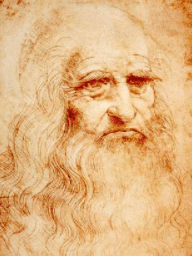 The self-portrait is by Leonardo da Vinci (1450 -1519) who had an amazing range of interest from botany and anatomy to mathematics and art. He painted the Mona Lisa and The Last Supper.One of his dreams was to be able to fly. He spent years observing birds in flight and designed a flying machine.He signed his name Leonardo da Vinci disciple of experiment.Q. What was the area of interest of Leonardo da Vinci?
The self-portrait is by Leonardo da Vinci (1450 -1519) who had an amazing range of interest from botany and anatomy to mathematics and art. He painted the Mona Lisa and The Last Supper.One of his dreams was to be able to fly. He spent years observing birds in flight and designed a flying machine.He signed his name Leonardo da Vinci disciple of experiment.Q. What was the area of interest of Leonardo da Vinci?- a)He took interest in botany, anatomy, mathematics and art
- b)He took interest in European paintings
- c)He took interest in politics
- d)He took interest in religious transformation
Correct answer is option 'A'. Can you explain this answer?
Direction: Look at this picture and study the extract carefully and answer ANY THREE of the following questions by choosing the correct option:

The self-portrait is by Leonardo da Vinci (1450 -1519) who had an amazing range of interest from botany and anatomy to mathematics and art. He painted the Mona Lisa and The Last Supper.
One of his dreams was to be able to fly. He spent years observing birds in flight and designed a flying machine.
He signed his name Leonardo da Vinci disciple of experiment.
Q. What was the area of interest of Leonardo da Vinci?
a)
He took interest in botany, anatomy, mathematics and art
b)
He took interest in European paintings
c)
He took interest in politics
d)
He took interest in religious transformation
|
|
Rajesh Gupta answered |
Da Vinci's interests ranged far beyond fine art. He studied nature, mechanics, anatomy, physics, architecture, weaponry and more, often creating accurate, workable designs for machines like the bicycle, helicopter, submarine and military tank that would not come to fruition for centuries.
Direction: Look at this picture and study the extract carefully and answer ANY THREE of the following questions by choosing the correct option: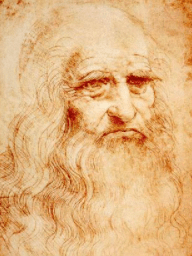 The self-portrait is by Leonardo da Vinci (1450 -1519) who had an amazing range of interest from botany and anatomy to mathematics and art. He painted the Mona Lisa and The Last Supper.One of his dreams was to be able to fly. He spent years observing birds in flight and designed a flying machine.He signed his name Leonardo da Vinci disciple of experiment.Q. Name the world-famous paintings made by Leonardo da Vinci?
The self-portrait is by Leonardo da Vinci (1450 -1519) who had an amazing range of interest from botany and anatomy to mathematics and art. He painted the Mona Lisa and The Last Supper.One of his dreams was to be able to fly. He spent years observing birds in flight and designed a flying machine.He signed his name Leonardo da Vinci disciple of experiment.Q. Name the world-famous paintings made by Leonardo da Vinci?- a)Mona Lisa
- b)The Last Supper
- c)The Pieta
- d)Both (a) and (b)
Correct answer is option 'D'. Can you explain this answer?
Direction: Look at this picture and study the extract carefully and answer ANY THREE of the following questions by choosing the correct option:

The self-portrait is by Leonardo da Vinci (1450 -1519) who had an amazing range of interest from botany and anatomy to mathematics and art. He painted the Mona Lisa and The Last Supper.
One of his dreams was to be able to fly. He spent years observing birds in flight and designed a flying machine.
He signed his name Leonardo da Vinci disciple of experiment.
Q. Name the world-famous paintings made by Leonardo da Vinci?
a)
Mona Lisa
b)
The Last Supper
c)
The Pieta
d)
Both (a) and (b)
|
|
Rajesh Gupta answered |
Leonardo da Vinci's Mona Lisa and The Last Supper occupy unique positions as the most famous, most reproduced, most parodied portrait and religious painting of all time.
Direction: Study the given picture from Changing Cultural Traditions carefully and answer ANY THREE questions from the below-mentioned questions with correct options: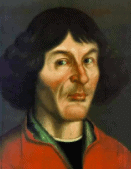 Q. Name the famous person shown in the picture:
Q. Name the famous person shown in the picture:- a)Johannes Kepler
- b)Copernicus
- c)Martin Luther
- d)Joachim Rheticus
Correct answer is option 'B'. Can you explain this answer?
Direction: Study the given picture from Changing Cultural Traditions carefully and answer ANY THREE questions from the below-mentioned questions with correct options:

Q. Name the famous person shown in the picture:
a)
Johannes Kepler
b)
Copernicus
c)
Martin Luther
d)
Joachim Rheticus
|
|
Kiran Mehta answered |
Nicolaus Copernicus was a Renaissance polymath, active as a mathematician, astronomer, and Catholic canon, who formulated a model of the universe that placed the Sun rather than Earth at its center.
Direction: Study the given picture from Changing Cultural Traditions carefully and answer ANY THREE questions from the below-mentioned questions with correct options: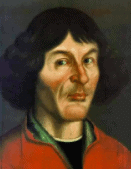 Q. Copernicus asserted that the planets including earth revolve around Sun.
Q. Copernicus asserted that the planets including earth revolve around Sun.- a)The statement is True
- b)The statement is False
- c)The statement is partially True
- d)None of these
Correct answer is option 'A'. Can you explain this answer?
Direction: Study the given picture from Changing Cultural Traditions carefully and answer ANY THREE questions from the below-mentioned questions with correct options:

Q. Copernicus asserted that the planets including earth revolve around Sun.
a)
The statement is True
b)
The statement is False
c)
The statement is partially True
d)
None of these
|
|
Kiran Mehta answered |
Copernicus was not the first to propose a model of the solar system in which the Earth and planets revolved around the sun, his model of a heliocentric universe was both novel and timely. For one, it came at a time when European astronomers were struggling to resolve the mathematical and observational problems that arose out of the then-accepted Ptolemaic model of the universe, a geocentric model proposed in the 2nd century CE.
Direction: Look at this picture and study the extract carefully and answer ANY THREE of the following questions by choosing the correct option: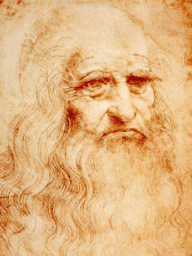 The self-portrait is by Leonardo da Vinci (1450 -1519) who had an amazing range of interest from botany and anatomy to mathematics and art. He painted the Mona Lisa and The Last Supper.One of his dreams was to be able to fly. He spent years observing birds in flight and designed a flying machine.He signed his name Leonardo da Vinci disciple of experiment.Q. What do you know about Leonardo da Vinci?
The self-portrait is by Leonardo da Vinci (1450 -1519) who had an amazing range of interest from botany and anatomy to mathematics and art. He painted the Mona Lisa and The Last Supper.One of his dreams was to be able to fly. He spent years observing birds in flight and designed a flying machine.He signed his name Leonardo da Vinci disciple of experiment.Q. What do you know about Leonardo da Vinci?- a)He was a humanist.
- b)He was an Italian Renaissance philosopher.
- c)He was a scientist.
- d)He was a famous painter of Italy.
Correct answer is option 'D'. Can you explain this answer?
Direction: Look at this picture and study the extract carefully and answer ANY THREE of the following questions by choosing the correct option:

The self-portrait is by Leonardo da Vinci (1450 -1519) who had an amazing range of interest from botany and anatomy to mathematics and art. He painted the Mona Lisa and The Last Supper.
One of his dreams was to be able to fly. He spent years observing birds in flight and designed a flying machine.
He signed his name Leonardo da Vinci disciple of experiment.
Q. What do you know about Leonardo da Vinci?
a)
He was a humanist.
b)
He was an Italian Renaissance philosopher.
c)
He was a scientist.
d)
He was a famous painter of Italy.
|
|
Rajesh Gupta answered |
While Leonardo da Vinci is best known as an artist, his work as a scientist and an inventor make him a true Renaissance man. He serves as a role model applying the scientific method to every aspect of life, including art and music. Although he is best known for his dramatic and expressive artwork, Leonardo also conducted dozens of carefully thought out experiments and created futuristic inventions that were groundbreaking for the time.
Direction: Read the following extract carefully and answer ANY THREE of the following questions by choosing the correct option:In 1517, a young German Monk called Martin Luther (1483 – 1546) launched a campaign against the Catholic Church and argued that a person did not need priests to establish contact with God. He asked his followers to have complete faith in God, for faith alone could guide them to the right life and entry into heaven. This movement - called the Protestant Reformation - led to the churches in Germany and Switzerland breaking their connection with the Pope and the Catholic Church. In Switzerland, Luther’s ideas were popularized by Ulrich Zwingli (1484-1531) and later by Jean Calvin (1509 – 64). Backed by merchants, the reformers had greater popular appeal in towns, while in rural area the Catholic Church managed to retain its influence. Other German reformers, like the Anabaptists, were even more radical: they blend it the idea of salvation with the end of all forms of social oppression. They said that since God had created all people as equal, they were not expected to pay taxes and had the right to choose their priests. This appealed to peasants oppressed by feudalism.Q. According to the given information who was Martin Luther?- a)He was a great philosopher of Spain
- b)He was a famous historian of Florence
- c)He was the leader of protestant reformation movement
- d)He was a professor in Padua university
Correct answer is option 'C'. Can you explain this answer?
Direction: Read the following extract carefully and answer ANY THREE of the following questions by choosing the correct option:
In 1517, a young German Monk called Martin Luther (1483 – 1546) launched a campaign against the Catholic Church and argued that a person did not need priests to establish contact with God. He asked his followers to have complete faith in God, for faith alone could guide them to the right life and entry into heaven. This movement - called the Protestant Reformation - led to the churches in Germany and Switzerland breaking their connection with the Pope and the Catholic Church. In Switzerland, Luther’s ideas were popularized by Ulrich Zwingli (1484-1531) and later by Jean Calvin (1509 – 64). Backed by merchants, the reformers had greater popular appeal in towns, while in rural area the Catholic Church managed to retain its influence. Other German reformers, like the Anabaptists, were even more radical: they blend it the idea of salvation with the end of all forms of social oppression. They said that since God had created all people as equal, they were not expected to pay taxes and had the right to choose their priests. This appealed to peasants oppressed by feudalism.
Q. According to the given information who was Martin Luther?
a)
He was a great philosopher of Spain
b)
He was a famous historian of Florence
c)
He was the leader of protestant reformation movement
d)
He was a professor in Padua university
|
|
Kiran Mehta answered |
Martin Luther, often called the father of Protestantism, fundamentally changed the Christian world through his force of will and new ideas.
Identify the following image and write their names: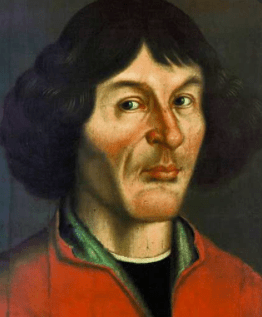
- a)Self-portrait by Leonardo Da Vinci
- b)self-portrait by Robert Cornelius
- c)Self-portrait by Copernicus
- d)None of the above
Correct answer is option 'C'. Can you explain this answer?
Identify the following image and write their names:

a)
Self-portrait by Leonardo Da Vinci
b)
self-portrait by Robert Cornelius
c)
Self-portrait by Copernicus
d)
None of the above
|
|
Rajesh Gupta answered |
Nicolaus Copernicus was an astronomer who proposed a heliocentric system, that the planets orbit around the Sun; that Earth is a planet which, besides orbiting the Sun annually, also turns once daily on its own axis; and that very slow changes in the direction of this axis account for the precession of the equinoxes.
Identify the following image and write their names: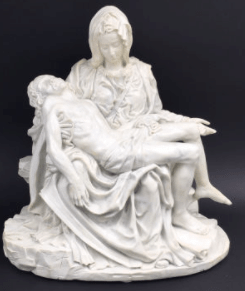
- a)‘The Pieta’ by Michelangelo depicts Mary holding the body of Jesus.
- b)The Communion of the Apostles, by Luca Signorelli, 1512
- c)Adoration of the Shepherds by Gerard van Honthorst
- d)Jesus before Pilate before his death.
Correct answer is option 'A'. Can you explain this answer?
Identify the following image and write their names:

a)
‘The Pieta’ by Michelangelo depicts Mary holding the body of Jesus.
b)
The Communion of the Apostles, by Luca Signorelli, 1512
c)
Adoration of the Shepherds by Gerard van Honthorst
d)
Jesus before Pilate before his death.
|
|
Rajesh Gupta answered |
The Pietà was a popular subject among northern european artists. It means Pity or Compassion, and represents Mary sorrowfully contemplating the dead body of her son which she holds on her lap. This sculpture was commissioned by a French Cardinal living in Rome.
Direction: Study the given picture from Changing Cultural Traditions carefully and answer ANY THREE questions from the below-mentioned questions with correct options: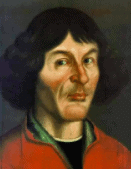 Q. Copernicus was a devout Christian.
Q. Copernicus was a devout Christian.- a)The statement is True
- b)The statement is False
- c)The statement is partially True
- d)None of these
Correct answer is option 'A'. Can you explain this answer?
Direction: Study the given picture from Changing Cultural Traditions carefully and answer ANY THREE questions from the below-mentioned questions with correct options:

Q. Copernicus was a devout Christian.
a)
The statement is True
b)
The statement is False
c)
The statement is partially True
d)
None of these
|
|
Kiran Mehta answered |
Copernicus was a devout man, anxious to serve both the world of natural philosophy and the church and hesitated to publish findings that contradicted the church. However, his theories eventually became public and they were accepted by many scientists of the day.
Identify the following image and write their names: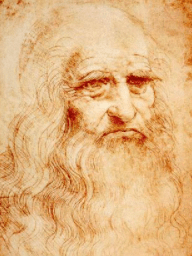
- a)Self-portrait by Robert Cornelius
- b)Self-portrait by Leonardo Da Vinci
- c)Self-portrait by Rembrandt Harmenszoon van Rijn
- d)None of the above
Correct answer is option 'B'. Can you explain this answer?
Identify the following image and write their names:

a)
Self-portrait by Robert Cornelius
b)
Self-portrait by Leonardo Da Vinci
c)
Self-portrait by Rembrandt Harmenszoon van Rijn
d)
None of the above
|
|
Rajesh Gupta answered |
This self portrait was painted in 1512 using red chalk, when Leonardo da Vinci was 50 and living in France. The original painting measures 33.3 x 21.3 cm (13 1/8 x 8 3/8 in). It is now held in the magnificent collection of the Biblioteca Reale, Turin.
Chapter doubts & questions for Changing Cultural Traditions - Famous Books for UPSC Exam (Summary & Tests) 2025 is part of UPSC CSE exam preparation. The chapters have been prepared according to the UPSC CSE exam syllabus. The Chapter doubts & questions, notes, tests & MCQs are made for UPSC CSE 2025 Exam. Find important definitions, questions, notes, meanings, examples, exercises, MCQs and online tests here.
Chapter doubts & questions of Changing Cultural Traditions - Famous Books for UPSC Exam (Summary & Tests) in English & Hindi are available as part of UPSC CSE exam.
Download more important topics, notes, lectures and mock test series for UPSC CSE Exam by signing up for free.
Famous Books for UPSC Exam (Summary & Tests)
773 videos|1444 docs|633 tests
|
Related UPSC CSE Content

Contact Support
Our team is online on weekdays between 10 AM - 7 PM
Typical reply within 3 hours
|
Free Exam Preparation
at your Fingertips!
Access Free Study Material - Test Series, Structured Courses, Free Videos & Study Notes and Prepare for Your Exam With Ease

 Join the 10M+ students on EduRev
Join the 10M+ students on EduRev
|

|
Create your account for free
OR
Forgot Password
OR
Signup to see your scores
go up
within 7 days!
within 7 days!
Takes less than 10 seconds to signup


